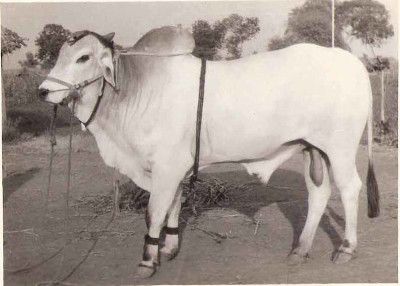Nanna races against time

నాన్న (Nanna is dad in Telugu) worked for the Government of Andhra Pradesh as a veterinary doctor. The Government of Andhra Pradesh and other states in India provide free medical care for the livestock in villages and free medical care for pets in larger cities. His job took us to many places around the state. We moved once every one and a half to two years like clockwork from one village to another. These were small farming villages full of farmers who needed a veterinary doctor to help to keep their cows, bulls, and water buffaloes healthy. Their livelihood depended on keeping their livestock healthy. Bulls were used to plough the fields and pull carts, cows and water buffaloes for milk, and chickens for eggs.
Most farmers had one or two cows, at least two bulls, and several chickens. నాగలి (Nagali) is used to plough the fields with two bulls pulling it through the dirt. Farmers took good care of their livestock. In a village with 200 households, if each household had at least 2 cows and 2 bulls, the total number would easily be 1000+. It won’t be out of ordinary for a village to be home for more animals than people. One might find life in villages boring and dull, but if your father was a veterinary doctor, it can be exciting. Nanna often came back from the hospital with an amusing story about an animal or a farmer. On occasion, farmers would bring their cows and buffaloes to our home for emergency treatment. I had the pleasure of watching Nanna treat them.
One evening a farmer brought his sick water buffalo to our home for a checkup. I was intently watching Nanna treating the water buffalo and administering an injection. A syringe with a large diameter is used for large animals like cows and buffaloes. The syringe looked humongous to me. I was glad I wasn’t the one getting the injection. Nanna threw the syringe full of medication at the buffalo’s back with some force and skill and it landed squarely on the right side of the buffalo's back. It was amazing to watch such a precise throw. I think Nanna would have been good at a game of darts.
One day a farmer stopped by asking Nanna about the ill effects of taking fertility medication given to his cow. He happened to keep cow’s medication in the right pocket of his లాల్చీ (Laalchi is long white shirt in Telugu) and his heart medication in the left pocket. He ended up mixing them up. Nanna joked with him about how he was ready for an artificial insemination and then assured him that there would be no ill effects from taking the cow pills. Sadly the farmer, who was also our landlord, passed away a few days later. I wonder even now if he stressed out about the side effects of taking the cow pills.
Veterinary hospitals in villages also provided artificial insemination services for cows and buffaloes. The hospitals would receive semen from a prized Bull in the state once a year. Nanna and his staff, a Compounder and two Attendants would go around artificially inseminating cows.
Nanna had two Attendants, బ్రహ్మం (Brahmam) and ఏసురత్నం (Yesuratnam). They lived in the same village following their ancestors who lived there for centuries. A third Attendant, Ahmed, commuted by bus from a nearby town. He took an early morning bus to work and went back home in the evening. Amma and Nanna used to give him shelter when he couldn't go back home during cyclones and storms. Amma would make extra food for him. He was very thankful for Amma's hospitality. బ్రహ్మం (Brahmam) was younger of the three Attendants. He was very friendly and used to chat with us. We bought milk and fish from his family and friends. He used to stop by home at least once or twice a day bringing milk, fish, and village news. He had a pleasant disposition and fun to interact with.
After artificially inseminating cows, they would track if their attempts were successful. This was of course the times before Google surveys. They used large ledgers to tabulate the information. Attendants at the veterinary hospital would go around the village asking villagers if their cow was pregnant. The Attendants who went around collecting data on cows were illiterate. Nanna would write down the table header and show them which column to check after collecting the information. They would fill the ledgers oftentimes blindly copying what Nanna wrote in the header fields into other rows as they collect the information or simply put a check mark. My sister and I would change a word to a funny nonsensical word as a prank. After that all the rows would be filled with the nonsensical word and Nanna would ask us to cease and desist.
The table looked like this:
బ్రహ్మం (Brahmam) would bring all the ledgers home at the end of the day after completing the rounds. I used to help Nanna with accounting and tabulating the numbers of pregnant cows and the ones that didn’t get pregnant. This process that started with an injection, lasted for about 3 months ending with confirmation of pregnancy. They kept meticulous records of how many cows were administered artificial insemination, how many cows got pregnant, and how many calves were born. I knew more than I probably should have known at age thirteen about prized Ongole bulls, insemination, pregnancies, and calves.
Ongole cattle are a tough breed with a rapid growth rate, natural tolerance to tropical heat and diseases. They are an indigenous cattle breed that originates from Ongole in Prakasam District in the state of Andhra Pradesh in India. The Ongole breed of cattle, also known as humped cattle, is in great demand as it is believed to be resistant to both foot and mouth disease and mad cow disease.
The Ongole bulls are native to the region fed by the Gundlakamma, and the Paleru river. The Gundlakamma river originates from the Nallamala Hills. The Paleru river is a tributary of the Krishna River that flows through the plains. Ongole bulls left their native grazing lands and can now be found in America, the Netherlands, Malaysia, Brazil, Argentina, Colombia, Mexico, Paraguay, Indonesia, West Indies, Australia, Fiji, Mauritius, Indo-China and Philippines. The American Brahmana bull is an off-breed of the Ongole bull. There are several millions of Ongole off-breed bulls in Brazil and they are called Nelore bulls. The famous Santa Gertrudis cattle breed from Texas, USA has Ongole blood. The Ongole breed is the largest cattle breed by numbers in the world, by beating even the Wildebeest of Africa.

A good friend who is a Veterinary Doctor, filled in the missing details about my speculation. Her work included frozen semen processing, preservation, and distribution. Pedigree bulls are well maintained, their semen is collected using an artificial vagina. Once the semen is collected it is graded using the phase contrast microscopes, adding preservative nutrients before freezing it at 196 degree Celsius. A lot of work happens before this prized semen makes it to Veterinary hospitals in villages.
Another good friend who is a Computer Engineer filled me in on the modern processes used in New Zealand for tracking instead of using ledgers. She designs and develops mobile devices that get used for field data collection for artificial insemination, hence they need to be sturdy enough to survive the dirty environmental conditions at the rear end of cows. This process creates good quality calves and milk production. Now you know the answer to why our milk tastes so good. Tons of behind the scenes hard work is done by Veterinary doctors, Computer engineers, technicians, and dairy farmers to make it happen.
I was curious about this prized Ongole bull chosen for breeding the next generation of calves. Nanna told me that this bull was housed in an Animal Husbandry facility in Hyderabad and cared for well. I would say, it is a nice gig for the bull compared to what other bulls have to do for a living. There is no need to endure getting tied to a నాగలి (Nagali) to plough the fields all day long in hot sun and pulling carts full of humans and their stuff. When you are the chosen one, manual labor is beneath you even if you are a bull. I imagined this bull sitting on a couch with his feet up on a coffee table in a fancy hotel, smoking a cigar, being served hand and foot by Attendants, and Veterinary doctors in white coats monitoring his health. I speculate this is how Ongole bulls took over the world as the largest cattle breed beating all others.
If this wasn’t all fun and exciting, one day there was a knock on the door at midnight. We all woke up to find a group of farmers at our front door frantically asking for help. A rabid dog had been running from house to house biting cows, bulls, buffaloes, and other animals. Since it happened at night, the dog targeted just the animals, and humans were spared. If nothing was done, in a few hours the entire animal population in the village could become infected and die. Rabies is spread most commonly by infected dogs. It causes encephalitis in humans and other mammals and is fatal if measures aren’t taken within a short period of time. It spreads very quickly when an infected animal bites or scratches a human or other animals. Saliva from an infected animal can also transmit rabies if the saliva comes into contact with the eyes, mouth, or nose. Nanna was once bitten by a stray dog when he was riding a scooter and had rested his foot down on the ground at a traffic light. He immediately went to get vaccinated against Rabies.
Rabies vaccine can be used to prevent rabies before, and, for a period of time, after exposure to the rabies virus. Nanna's race began to vaccinate all the animals in the village whether they were bitten by the rabid dog or not. Nanna, Compounder, and Attendants ran from house to house injecting animals with rabies vaccine following the dog’s footsteps as the villagers were helping them retrace the dog's path of biting expedition. They spent all night and well into the morning to save the animals. Thankfully there was enough vaccine to go around to save all the animals in the village.
